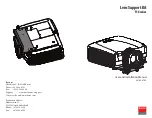
6. Lateral approach and distances
7. Tips on flush and non-flush mounting in metal
Installation instructions for cylindrical designs
The principle of inductive sensor technology is based on an electromagnetic alternating field created
via a copper coil embedded in an open pot core made of ferrite. An resonant circuit is created using
the capacitor. Thanks to an electrically conductive metal, located within a certain range in front of the
sensor, the eddy currents of the magnetic field are strongly attenuated. These changes in the oscilla-
tion amplitude are detected by the sensor and the sensor is switched.
1. Typical switch-on curve (for slow approach)
2. Typical switch-off curve (for slow approach)
3. Poor repeatability
4. Good repeatability
The following applies for good repeatability of the
switch point: The closer the damping element is to
the sensor face the better. General recommendation:
a = 10% of the nominal sensing range.
1. Distance to the background
2. Recommended target distance
3. Recommended degree of coverage of
the sensing face
4. Recommended target size
The special feature of sensors which can be installed flush is the additional outer metal ring which
surrounds the coil. This shields the alternating field and bundles it at the front.
non-flush mountable
sensor
Shielded coil with a flush
mountable sensor






































